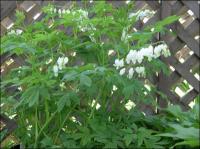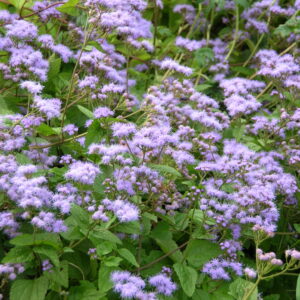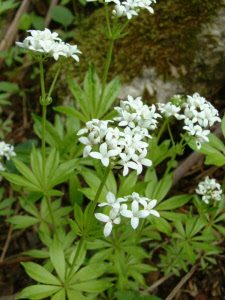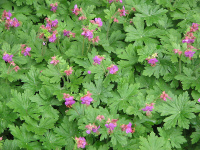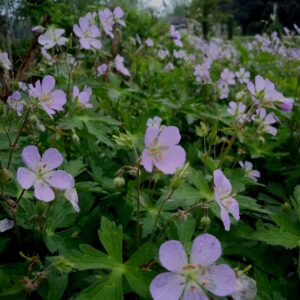Black Walnut Tolerant
Showing 41–48 of 110 results
-
Dicentra spectablis Alba syn Lamprocapnos spectabilis White bleeding heart Z 3-9
Dangling alabaster, heart shaped blossoms
May – June Legendary dangling alabaster, heart shaped blossoms. One of the best.
Size: 36" x 18"
Care: Part shade to shade in moist well-drained soil.
Native: JapanDicentra derived from Greek dis meaning “two” and kentros meaning “spurs.” The white form in gardens in the West 1877.
-
Dicentra spectablis syn Lamprocapnos spectabilis Bleeding Heart Z 3-9
May - June legendary dangling dark pink heart shaped blossoms. One of the best.
OUT OF STOCK
From May through June legendary dangling, dark pink heart-shaped blossoms. One of the best.
Size: 36" x 18"
Care: Part shade to shade, moist well-drained soil.
Native: Japan
Awards: Royal Horticultural Society Award of MeritDicentra derived from Greek dis meaning “two” and kentros meaning “spurs” because the flowers have two spurs. Spectabilis means “worthy of notice.” The Bleeding heart was a favorite garden plant in China for centuries before its discovery by Europeans. Introduced to the West in 1846 after Robert Fortune found it growing on the Island of Chusan and sent it to the Horticultural Society of London. It became an immediate sensation in England. By 1866 the Bleeding heart was available in America.
**LISTED AS OUT OF STOCK BECAUSE WE DO NOT SHIP THIS ITEM. IT IS AVAILABLE FOR PURCHASE AT OUR RETAIL LOCATION.
-
Eryngium yuccifolium Rattlesnake master Z 3-8
Blooms July-December, prickly round white umbels. Leaves like thinner versions of a Yucca.
Blooms July-December, prickly round white umbels. Leaves like thinner versions of a Yucca.
Size: 48” x 18”
Care: Full sun, moist well-drained soil
Native: Eastern United States, Wisconsin native
Wildlife Value: Supports over 40 bee species.
Awards: Missouri Botanic Garden Plant of Merit.Eryngium is Greek meaning “thistle.” The name “Rattlesnake master” comes from the use by Chickasaw shamans of chewing the root, blowing it on the hands and then picking up rattlers without injury or “from its virtues of curing the bite of that venomous reptile.” Gardeners’ Dictionary, 1768. Valued by Native Americans for medicinal uses: a diuretic, stimulant, and cure for venereal disease and impotence, purify blood; Chippewa for joint inflammation and strengthen young children and Cherokee as a toothache remedy; Sioux: Root cured bladder ailments, and rattlesnake bites and scorpion stings. A concentration of boiled root increased virility of Sioux men. The Forest Potawatomi used Rattlesnake master as a good luck charm – the top placed in a pocket made the gambler sure to win. Collected in Virginia by Rev. John Banister (1649-1692) who moved to colonial Virginia in 1678. A gunman mistakenly shot and killed him while he collected plants.
-
Eupatorium coelestinum syn. Conoclinium coelestinum, Coelestina ageratoides Blue mist Z 3-7
Clusters of cornflower blue in fall –close looks like a mophead of many strings, at a distance it looks like a big Ageratum - August to October.
Clusters of cornflower blue in fall –close looks like a mophead of many strings, at a distance it looks like a big Ageratum – August to October.
Size: 3' x 2-3'
Care: full sun in moist to moist well-drained soil.
Native: New Jersey west to Illinois south to Texas and east to Florida
Wildlife Value: nectar source for many butterflies and both nectar and pollen for many beesEupatorium named after Mithridates Eupator, ancient king of Pontus, Greece, said by Pliny to have used another species of Eupatorium medicinally in 1st century B.C. This species 1st collected by Quaker planthunter and nursery owner John Bartram (1699-1777) in 1732 and offered for sale in Bartram Garden’s 1783 Broadside, America’s 1st plant catalog.
-
Eupatorium purpureum syn. Eutrochium purpureum Sweet Joe Pye weed Z 4-9
July - September large dusty rose blooms invite butterflies.
July – September large dusty rose domes of bunches of flowers
Size: 5-6' x 3'
Care: Sun, moist, alkaline soil
Native: Eastern U.S., Wisconsin native
Wildlife Value: Nectar and/or pollen for numerous bees, butterflies, and waspsJoe Pye weed named after an Indian medicine man who used the plant in New England to cure typhus. Meskwaki Indian men “nibbled (Joe Pye weed) when speaking to women when they are in the wooing mood.” This had the power of “fetching” women. Good luck when gambling for the Potawatomi. Oneidas used it to cure fever. Mahuna Indians of So. California made an infusion of the root to cure colds and coughs. Colonists used the plant to cure dropsy, gravel, gout and rheumatism. Collected by Rev. John Banister (1649-1692) who moved to colonial Virginia in 1678. A gunman mistakenly shot and killed him while he collected plants. Offered for sale in Bartram Garden’s 1783 Broadside, America’s 1st plant catalog.
-
Galium odoratum Sweet woodruff, Bedstraw Z 4-8
Whorls of fine textured leaves, like spokes of a wheel, with white blooms in spring lighting up the shade
Whorls of fine textured leaves, like spokes of a wheel, with white blooms in spring lighting up the shade
Size: 6-12" x 18" spreading
Care: shade to part shade in moist to moist well-drained soil.
Native: Europe and Mediterranean areaCalled “Bedstraw” because, according to legend, Mary rested on hay of Bedstraw on Christmas. May wine made an ancient herbal remedy: handful of dried and crushed leaves plus fresh lemon juice steeped in wine for 3-4 hours “makes a man merry and (is) good for the heart and liver.” Garlands hanging in houses in summer “coole and make fresh the place, to the delight and comfort of such as are therein.” per English herbalist Gerard, 1633. Dried branches give a grassy vanilla fragrance, used in sachets and potpourris, as an insect repellant and to make grey-green dyes.
-
Geranium macrorrhizum Bigroot Geranium Z 4-8
Five raspberry-purple open petals showcase its tall, purple stamens beckoning come hither to bees. Blooms in early summer. Fragrant foliage smells like pine trees at Christmas. Good groundcover in dry shade
Five raspberry-purple open petals showcase its tall, purple stamens beckoning come hither to bees. Blooms in early summer. Fragrant foliage smells like pine trees at Christmas. Good groundcover in dry shade
Size: 20" x 24"
Care: part shade in moist well-drained to well-drained soil
Native: Southern Europe
Awards: Elisabeth Carey Miller Botanical Garden Great Plant Pick.Geranium is Greek meaning “crane” referring to the shape of its seed resembling the bill of a crane. Cultivated in England by 1600.
-
Geranium maculatum American Cranesbill, Wild geranium, Spotted geranium Z 3-8
Saucer-shaped, five rose-pink to lilac oval petals with darker veins to the center, guiding pollinators to its nectar, surround ten upright stamens bearing yellow pollen in the center bloom in mid to late spring and early summer if cool.
Saucer-shaped, five rose-pink to lilac oval petals with darker veins to the center, guiding pollinators to its nectar, surround ten upright stamens bearing yellow pollen in the center bloom in mid to late spring and early summer if cool.
Size: 24" x 18"
Care: Full sun to part shade in moist to moist well-drained soil
Native: East North America, Wisconsin native.
Wildlife Value: Nectar and pollen source for hummingbirds, bees and butterfliesNative Americans taught colonists to use the plant to cure diarrhea, dysentery and hemorrhaging. Also used on sores, open wounds, canker sores and sore feet. The Choctaw prescribed it for venereal disease. Sent to Europe in 1732 This species collected by French planthunter André Michaux (1746-1802) who spent 11 years collecting plants in the US. Jefferson asked John Bartram to obtain seeds, 1786. Pressed specimen in Emily Dickinson’s herbarium.

